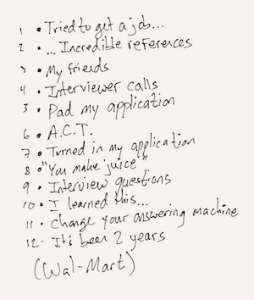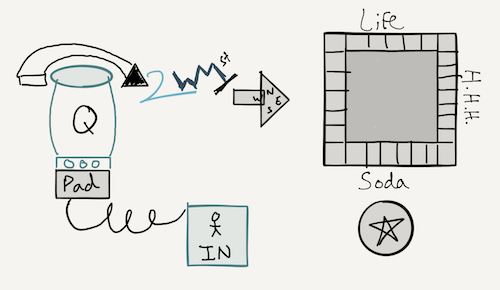This is a ridiculously awesome way of remembering your set.
I’ve been very open about my past struggle with stage-fright and perfectionism. The intense fear I felt early in my career lead me to search for better ways of remembering my material. I developed this strategy for remembering comedy material very early in my career and I never stopped using it.
The perfect set list should …
- … be very discrete. The less attention it gets the better.
- … be very easy to read. You shouldn’t need to bend down or squint to make out the words.
- … be very fast. You should be able to figure out exactly where you are in a split second.
The best set list is the setlist that you don’t actually need to look at. Ideally, the setlist will stay in your pocket for the entire performance. Set lists are for emergencies only. The main benefit of having a setlist with you on stage is that it provides comfort and security. Knowing that you have a backup plan relaxes you on stage and allows you to be more personable.
The problems with most set lists.
- It’s difficult to read tiny words on stage without being very obvious, but large words leave no room for material.
- Quick glances at your set list are difficult. You have to begin at the first bullet point and then scan down before figuring out which bullet point you’re on. That can take a lot of time.
- It’s very difficult to remember which bullet point goes where. There’s nothing to stop you from going out of order unless you’re checking your setlist on stage.
Here’s how my set list would appear using a conventional strategy.
Imagine being on stage and having this in your pocket.
- Could you keep this set list in your head without looking at it?
- What is there to stop #4 and #5 from switching around? Nothing. If you’re on stage and you’re trying to remember the next joke without looking at your set list then you’ll try to imagine this picture. How fast and accurate cold you be?
- Try this exercise: look at this set list for 15 seconds then try to rewrite the set list from memory. If you’re good, you might get 50% or so… but it’d be very difficult.
- Try the same exercise with my set list below and see if you can recreate it from memory.
Now lets look at my strategy for set lists in action…
My Set List From 2008
Here’s a picture of the first set list I ever made using this strategy.
The picture on the left was the original bit I wrote about being turned down for a job at Jamba Juice. The picture on the left segues into my experience working at Wal-Mart, a bit that I still perform. All told, this set list represents 21 jokes directly, but it indirectly represents over 15 minutes of material.
The more I use this strategy, the less detail I need to put in the picture. Some jokes naturally lead you into the next one in a way that makes it easy to remember, so there’s no need to represent every single joke on the set list. The worst that could happen is that I forget a joke not represented and skip to the next “large” joke in the bit. As an audience member, you’d never know I had made a mistake.
When people see this at a show, they generally look confused at first, but after I explain to them how it works they get excited about trying it out using their own material.
My Set List…
- Doesn’t require any words at all. Zero reading necessary (though optional). I never have to squint to see a word.
- Shows me exactly where I am in my performance without needing to scan down bullet points in my notes. I don’t have to scan through joke 1-10 to figure out which joke is 11. I can go straight to 11.
- Makes it nearly impossible to mix up the order of my material. If I used conventional bullet points then it’d be very easy to switch them around. It’s impossible to switch the picture around in your head. Joke 10 is always after joke 9 and before 11. To change the order of material, I draw a new picture. The mental image of my set list cannot change, but the mental image of a normal set list is very difficult to keep from changing.
- Makes it very unlikely that I’ll even need to look at my set list at all. If I do it right, it’ll stay in my pocket for the entire set. That’s because by the time I reach for the set list in my pocket and pull it out, I can already see exactly what the picture looks like in my head. So it’s actually faster to not use my set list than to use it.
- Works for any amount of time. I’ve used it for doing 2-5 minute up mic sets and for doing over an hour.
Here’s how powerful this strategy for remembering your performance can be. This setlist was made in 2008. This was the height of my stage-fright years and I was still relatively new. I haven’t performed the first half of this set in over 6 years. As I became a better writer and performer, this bit gradually went from something I was proud of to something that was holding back the rest of my performance.
It first used this in 2008 and I can still tell you exactly…
- … what each symbol means on the set list
- … what word or phrase begins each symbol
- … the exact order of each joke, from opener to segue into other material.
Here’s what going through my set list would look like. That means I could literally throw this material back on stage at any moment. I could even decide to throw it into a performance while I’m on stage without messing up my rhythm or potentially forgetting where I left off.


